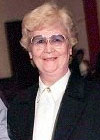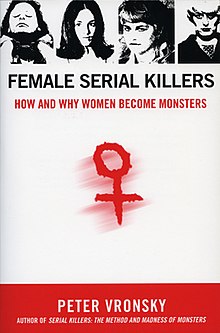
A serial killer is a person who murders three or more people, with the killings taking place over a significant period of time in separate events. Their psychological gratification is the motivation for the killings, and many serial murders involve sexual contact with the victims at different points during the murder process. The United States Federal Bureau of Investigation (FBI) states that the motives of serial killers can include anger, thrill-seeking, financial gain, and attention seeking, and killings may be executed as such. The victims tend to have things in common, such as demographic profile, appearance, gender, or race. As a group, serial killers suffer from a variety of personality disorders. Most are often not adjudicated as insane under the law. Although a serial killer is a distinct classification that differs from that of a mass murderer, spree killer, or contract killer, there are overlaps between them.
The Hillside Strangler, later the Hillside Stranglers, is the media epithet for one, later discovered to be two, American serial killers who terrorized Los Angeles, California, between October 1977 and February 1978, with the nicknames originating from the fact that many of the victims' bodies were discovered in the hills surrounding the city.
Lust murder, also called sexual homicide, is a homicide which occurs in tandem with either an overt sexual assault or sexually symbolic behavior. Lust murder is associated with the paraphilic term erotophonophilia, which is sexual arousal or gratification contingent on the death of a human being. The term lust killing stems from the original work of Richard von Krafft-Ebing in his 1898 discussion of sadistic homicides. Commonly, this type of crime is manifested either by murder during sexual activity, by mutilating the sexual organs or areas of the victim's body, or by murder and mutilation. The mutilation of the victim may include evisceration, displacement of the sexual organs, or both. The mutilation usually takes place postmortem. Although the killing sequence may include an act of sexual intercourse, sexual intercourse does not always occur, and other types of sexual acts may be part of the homicide.
A thrill killing is premeditated or random murder that is motivated by the sheer excitement of the act. While there have been attempts to categorize multiple murders, such as identifying "thrill killing" as a type of "hedonistic mass killing", actual details of events frequently overlap category definitions making attempts at such distinctions problematic.

Robert Kenneth Ressler was an American FBI agent and author. He played a significant role in the psychological profiling of violent offenders in the 1970s and is often credited with coining the term "serial killer", though the term is a direct translation of the German term Serienmörder coined in 1930 by Berlin investigator Ernst Gennat. After retiring from the FBI, he authored a number of books on serial murders, and often gave lectures on criminology.

David Michael Krueger, best known by his birth name Peter Woodcock, was a Canadian serial killer, child rapist and diagnosed psychopath. He gained notoriety for the murders of three young children in Toronto in the late 1950s, as well as for a murder in 1991 on his first day of unsupervised release from the psychiatric institution in which he had been incarcerated for his earlier crimes.

Offender profiling, also known as criminal profiling, is an investigative strategy used by law enforcement agencies to identify likely suspects and has been used by investigators to link cases that may have been committed by the same perpetrator. The originator of modern profiling was FBI agent Robert Ressler. He defined profiling as the process of identifying all psychological characteristics of an individual and forming a general description of their personality based on an analysis of crimes they have committed.

Elfriede Martha Blauensteiner, dubbed The Black Widow, was an Austrian serial killer who murdered at least three victims by poison. In each case, she inherited the victim's possessions.

Richard Francis Cottingham is an American serial killer who was convicted in New York of six murders committed between 1972 and 1980 and convicted in New Jersey of twelve murders committed between 1967 and 1978. He was nicknamed by media as the Torso Killer and the Times Square Ripper, since some of the murders he was convicted of included mutilation.

Peter Vronsky is a Canadian author, filmmaker, and investigative historian. He holds a PhD in criminal justice history and espionage in international relations from the University of Toronto. He is the author of the bestseller true crime histories Serial Killers: The Method and Madness of Monsters (2004), Female Serial Killers: How and Why Women Become Monsters and Sons of Cain: A History of Serial Killers From the Stone Age to the Present (2018), a New York Times Editors' Choice, and most recently American Serial Killers: The Epidemic Years 1950–2000 (2021), a history exploring the epidemic surge of serial killers in the second half of the 20th century. He is the director of several feature films, including Bad Company (1980) and Mondo Moscow (1992). Vronsky is the creator of a body of formal video and electronic artworks and new media. He has also worked professionally in the motion picture and television industry as a producer and cinematographer in the field of documentary production and news broadcasting with CNN, CTV, CBC, RAI and other global television networks in North America and overseas. Vronsky's 2011 book, Ridgeway: The American Fenian Invasion and the 1866 Battle That Made Canada, is the definitive history of Canada's first modern battle – the Battle of Ridgeway fought against Irish American Fenian insurgents who invaded across the border from the United States on the eve of Canadian Confederation shortly after the American Civil War. He currently lectures at Toronto Metropolitan University's History Department in the history of international relations, terrorism, espionage, American Civil War, and the Third Reich. He consults as an investigative criminal historian to a number of law enforcement cold case homicide units including the NYPD, New York State Police, and Bergen County Prosecutor's Office New Jersey.

Lee Mellor is an Anglo-Canadian author, scholar, criminologist and songwriter.
Fictional portrayals of psychopaths, or sociopaths, are some of the most notorious in film and literature but may only vaguely or partly relate to the concept of psychopathy, which is itself used with varying definitions by mental health professionals, criminologists and others. The character may be identified as a diagnosed/assessed psychopath or sociopath within the fictional work itself, or by its creator when discussing their intentions with the work, which might be distinguished from opinions of audiences or critics based only on a character appearing to show traits or behaviors associated with an undefined popular stereotype of psychopathy.
Micki Pistorius is a South African forensic or investigative psychologist and author. She was the first woman in her profession and the first profiler in South Africa, working on many high-profile cases involving serial killers for the South African Police Service in the 1990s.

Charlie Chop-off is the pseudonym given to an unidentified American serial killer known to have killed three black children and one Puerto Rican child in Manhattan between 1972 and 1973. The assailant is also known to have attempted to murder one other child.

Serial Killers: The Method and Madness of Monsters (2004) is a non-fiction true crime history by Peter Vronsky, a criminal justice historian. It surveys the history of serial homicide, its culture, psychopathology, and investigation from the Roman Empire to the early 2000s. The book describes the rise of serial murder from its first early recorded instances in ancient Rome to medieval and Renaissance Europe, and Victorian Britain, and its rise and escalation in the United States and elsewhere in the world, in the postmodern era. The book also surveys a range of theoretical approaches to serial killers interspersed with dozens of detailed case studies of both notorious and lesser known serial murderers, illustrating the theory in practice. Considered by some a definitive history of serial homicide, this was the book serial killer Dennis Rader, the BTK Killer, was reading when he was arrested in 2005.
In France, rape is illegal, and marital rape is also illegal. In recent years there has been increase of reported rape cases in France.

Karen Franklin is an American forensic psychologist. For her doctoral dissertation, she conducted research on anti-gay violence. She has also published commentaries about sex crimes, primarily expressing her opposition to the use of the hebephilia and other diagnoses in sexually violent predator regulations. She received the 2012 Distinguished Scientific Achievement Award in Psychology and the Monette-Horwitz Trust Award in 2001.
Max Gufler was an Austrian serial killer who was convicted of killing four women. He was suspected of up to 18 murders. He was reportedly subject to outbursts of rage after being struck on the head with a rock at the age of nine. Gufler killed his victims after luring them with matrimonial advertisements.
Lloyd Clark Fletcher is an Australian convicted rapist and murderer whose most well known crime was the sexual assault and murder of 15 year old Janet Phillips in Wynnum, Queensland on 19 July 1987. He is currently serving an indefinite life sentence without possibility of parole in Queensland.
Themba Anton Sukude, also known as the Newcastle serial killer, is a South African serial killer who murdered four men and raped two women in Newcastle's Trim Park between February 2004 and January 2005. His initial modus operandi consisted of targeting couples. He would bludgeon the male with a rock and rape the female. However, he later switched to solely targeting men. He was caught in March 2005 after confessing to a stranger, and convicted of the crimes the following year. He is serving five life sentences as well as an additional 40 years.











